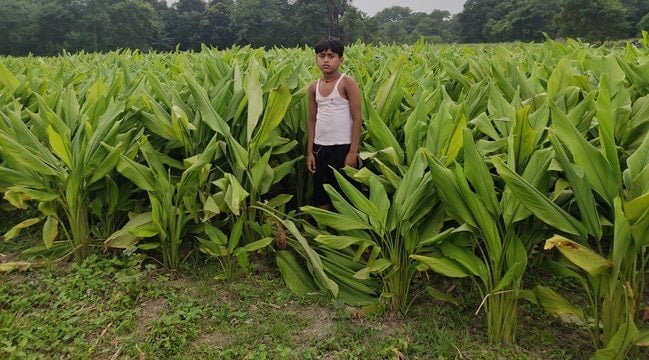This ultimate guide on turmeric farming will help you to know climate, soil, field preparation, propagation, fertilizers, irrigation, etc. Knowing these important factors can help in increasing overall turmeric yield in your farm.
Table of Contents
Turmeric Farming Guide

Climate & Temperature
For successful cultivation of turmeric, warm climate and well distributed 2500-4000 mm rainfall annually is beneficial. It requires average temperature range of 30-35° C, 20-25° C during rhizome formation and 18-20° C during rhizome ripening.
If there is no rain three weeks before harvesting, the conservation capacity of the rhizome increases.
Soil
You can cultivate turmeric on light loam to heavy loamy soil. Well drained, friable, sandy loam soil with high organic matter is considered best for its cultivation. 15-20 cm from the soil surface should be friable so that the rhizome can develop well. Alkaline soil is not suitable for turmeric cultivation.
Turmeric crop is very sensitive to water logging, hence avoid cultivating them in waterlogged areas.
Cultivars Of Turmeric
Suvarna: This variety is early maturing (in 200 days). Its yield is 17.4 tonnes per hectare.
Sudarshan: This variety is also early (190 days) maturing, yields 28.3 tonnes per hectare.
Lakadong: This variety matures in 200 days, yields 40 tons per hectare.
Prabha: The cropping period of this variety is 200 days, the yield is 37. ton per hectare.
Rajendra Sonia: Crop duration of this variety is 225 days, yield is 48 tonnes per hectare. This variety is disease resistant to leaf spot disease.
Sugandham: Crop duration of this variety is 210 days, yield is 15 tonnes per hectare.
Pant Pitabh: The crop duration of this variety is 210 days, yield is 25 tonnes per hectare. The rhizomes of this type are large and attractive.
Sowing Of Rhizomes
Generally, sowing of turmeric rhizome is done in the month of April-May. 25 quintals of rhizomes are sufficient for one hectare of land. Line to line distance in turmeric crop is 30-40 centimetres and the distance from the tuber to the plant is 20 centimetres.
Mulching
Immediately after sowing, practice mulching with 125-150 quintals per hectare of dry leaves or chopped straw. By laying mulch, the germination of the seed occurs quickly, which increases the yield of rhizomes. Second and third time mulching should be practiced at the rate of 50-60 quintals per hectare after 45 and 90 days of sowing.
You can get maximum yield by giving 50 percent shade to the plants, because turmeric is a shade loving plant, so it can be successfully intercropped.
You will also love reading them,
ALSO READ: Aloe Vera Farming Guide
ALSO READ: Tomato Cultivation Guide
Manures & Fertilizers
You can apply 30-40 tonnes per hectare decomposed cow dung or Farm Yard Manure and 120 kg. Nitrogen, 60 kg. phosphorus and 60 kg. potassium per hectare to increase overall yield. Apply half of nitrogen and full amount of Phosphorous and Potash in the field at the time of last ploughing.
Give the remaining half dose of nitrogen in two equal parts at 45 and 90 days intervals after sowing of rhizomes.
Irrigation
Irrigate your field according to the temperature and moisture content of the soil. At 90 and 135 days after sowing, soil moisture is necessary at the time of rhizome formation and development. Giving light irrigation 3-4 days before harvesting makes the crop easy to harvest.
Generally, when there is a shortage of water, you should give irrigation. Follow 10-15 days interval in summer days.
Inter-culture Operations
After removing weeds and fertilizing, it is necessary to apply soil around the plant so that the rhizomes can develop well and they are protected from sunlight.
Spray of Fluchloralin (1-0-1-5 kg/ha), or Pendimethylin (1.0-1.5 kg/ha) diluted in 500-600 litres of water before weeds grow to kill one-year-old weeds and broad-leafed weeds. But if mulch is well laid, then weeds do not cause much problem.
Diseases & Control
Leaf Spot: Generally this disease comes in August and September when there is constant moisture in the atmosphere. Brown spots appear on the leaves.
Leaf Blotch Disease: Generally this disease comes on the lower leaves in the month of October and November and causes great damage to the crop.
In this disease, many yellow spots are formed on both the surfaces of the leaves. These spots are more on the upper surface of the leaves. The diseased leaves curl up and turn brownish-reddish and fall off later.
Control Measures
- Select disease free rhizomes for seed.
- Before sowing, dry the rhizomes in shade by treating it with Indofil M-45 at the rate of 3 gm/Litre or Bavistin at the rate of 1 gm/Lit of water for 30 minutes.
- Collect and burn the sick leaves.
- Spray Indofil M-45, 2.5 g/Lit or Bavistin at the rate of 1 gm/Lit of water twice or thrice at an interval of 15 days.
- Adopt crop rotation of three to five years.
Rhizome rot or soft rot: It is caused by several species of fungus called Pythium. The edges of the leaves turn yellow and dry up. The adjacent part of the stem becomes soft and starts rotting, as a result of which the plant dies.
The rot travels through the stem to the rhizome. As a result they also start to rot. The crop is most affected by this disease at the age of three months.
Control Measures
- Treat the rhizomes used for seed by making a solution of 2.5 g agalol in one litre of water or with 0.3% mancozeb solution for 30 minutes. Only after this, the rhizomes should be used for storage or sowing.
- Removal of affected plants and washing the area with 0.3% mancozeb reduces the spread of the disease.
Pests & Control
Rhizome borer pest: It is the main pest that damages the turmeric crop. Its caterpillar enters the stem and makes dead tissue. Its adult insect is pink-yellow in colour and with black stripes on the wings. It lays eggs on leaves and other tender parts of the plant.
Its trunk is reddish brown in colour and with black spots all over the body. You can detect the presence of this insect from the holes on the stems and the dirt and dead parts of the insect coming out of it.
For the prevention of this pest, when the dead hearts start appearing, 1.0 ml of a drug called Rogar per litre is applied to control this pest.
Leaf Roller: Its nectar eats the folded leaves and lays eggs there. For its prevention, 1 ml of a drug called Rogar per litre is sprayed.
Scale insect: It harms the plant by sucking the juice of rhizome in the field and during storage. For its prevention, at the time of sowing treat the rhizomes with 1 ml of Malathion or Rogar in 1 litre of water.
Harvesting
When the leaves of turmeric turn yellow and dry, then the crop is ready for ripening. The crop is ready to ripen about 8 to 9 months after sowing. When the crop is ripe, cut leaves from near the ground and take out rhizomes from the ground.
Before curing the rhizomes, the mother rhizome is separated from other parts (fingers). The rhizomes which have not developed roots are kept in the shade for 2 to 3 days by making heaps so that their outer surface becomes hard and they can bear injury etc.
Generally, the yield of fresh turmeric is 150-250 quintals per hectare which is 40-60 quintals per hectare in the safe state.





